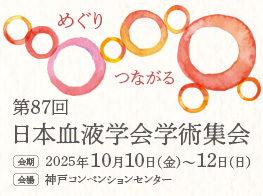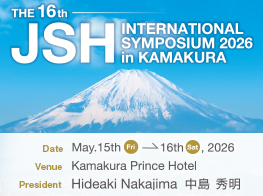
名前:材木義隆 【金沢大学医薬保健研究域医学系細胞移植学】
発表日時:2014年6月14日
発表形式:ポスター
Title:
A simple method to detect copy number-neutral 6p-loh in patients with acquired aplastic anemia using duplex quantitative PCR
Authors:
Yoshitaka Zaimoku1, Hiroyuki Maruyama1, Ayaka Amano1, Noriharu Nakagawa1, Chizuru Saito1, Takamasa Katagiri1, Hiroyuki Takamatsu1, Hirohito Yamazaki1, Koichi Kashiwase2, Shinji Nakao1
Affiliations:
1Cellular Transplantation Biology, Kanazawa University, Kanazawa,
2Japanese Red Cross Kanto-Koshinetsu Block Blood Center, Tokyo, Japan
Abstract:
Background
The presence of HLA allele-lacking leukocytes (HLA-LLs) due to copy number neutral loss of heterozygosity (LOH) as a result of uniparental disomy in the short arm of chromosome 6 (CNN-6pLOH) is compelling evidence for the immune pathophysiology of acquired aplastic anemia (AA), and may serve as a predictor of the response to immunosuppressive therapy. However, the high expenses associated with the SNP array analysis hinder the popularization of detecting 6pLOH in the management of AA. The presence of 6pLOH can also be estimated by detecting HLA-LLs using flow cytometry with monoclonal antibodies specific for HLA-A alleles, but this assay cannot be applied for a substantial number of homozygotes for the HLA-A allele, or for those harboring HLA-B*40:02, an allele closely associated with the immune pathophysiology of AA, against which monoclonal antibodies are not available.
Aim
To establish a cost-effective and reliable method for detecting 6pLOH involving class I HLAs, especially the one involving HLA-B*40:02, in the leukocytes of AA patients, we examined the usefulness of duplex quantitative real-time PCR (2qPCR), and applied this method to detect 6pLOH involving HLA-B and -C loci.
Methods
2qPCR was designed to compare the copy number of each allele in individuals heterozygous for the HLA-B or -C alleles. The 2qPCR allows the simultaneous amplification of each HLA-allele from genomic DNA in a single reaction. The PCR mixture contains two different TaqMan probes that are complementary to respective SNP sequences specific for individual HLA alleles, which are labeled with different fluorochromes (FAM and VIC), as well as one primer pair complementary to consensus sequences. Fluorescent intensity for each allele was plotted on the X-axis and Y-axis. The presence of 6pLOH led to deviation of tested samples from standard line generated from the heterozygotes, and 6pLOH clones were regarded to be significant if the distance of the sample dots from the standard line exceeded that of control dots that occurred as a result of nonspecific dispersion. The 6pLOH clone size could be estimated by the degree of deviation. The TaqMan probe mixtures (mixtures B and C) were designed to distinguish HLA-B*40:02 from the majority of the other HLA-B alleles, and HLA-C*03 from the other HLA-C alleles, respectively: HLA-C*03:03 and *03:04 are highly associated with HLA-B*40:02 due to linkage disequilibrium in Japanese population. Approximately 50% of Japanese individuals and 90% of those possessing at least one HLA-B*40:02 allele were expected be analyzable using the B or C reaction mixtures.
Results
Six 6pLOH (+) cases that had previously been identified by the SNP array were found to be positive for 6pLOH by the 2qPCR analysis. The estimated 6pLOH clone sizes were similar between the SNP array (range, 5.6% to 53.9%, median 19.6%) and the 2qPCR analysis (range, 11% to 48%, median 13%). When a new AA patient set was analyzed by 2qPCR, 6pLOH was found in 10 of 68 patients (15%), and the median clone size was 14% (range, 4%-50%). Six of the ten 6pLOH (+) cases were heterozygous for the HLA-A allele and were therefore analyzable with flow cytometry. HLA-LLs were detectable in all of the six patients. Consistent with our previous data, HLA loss due to 6pLOH was more frequently found in HLA-B*40:02 allele, compared to those with the other HLA-B alleles (20%, 6/30 vs 3.8%, 4/106; P= 0.008). The 2qPCR assay was completed within three hours after DNA preparation.
Summary/Conclusion
A rapid and cost effective method for detecting 6pLOH with high sensitivity and specificity was established. We are conducting mass screening of AA patients’ samples for the presence of 6pLOH. The 2qPCR method confirmed the preferential loss of HLA-B*40:02 due to 6pLOH in AA. Further studies to clarify the pathogenic antigens presented by HLA-B*40:02 are therefore warranted.
Keywords
Aplastic anemia, HLA, LOH, Real time PCR
EHA2014 参加報告
この度は、ミラノで開催された第19回ヨーロッパ血液学会への参加の機会をいただき、ありがとうございました。
ミラノは、6月とは思えないような暑さでしたが、湿度が低いためか過ごしやすい気候で、昼間から屋外の客席でワインを楽しむ人々をよく見かけました。市内には学会会場への移動や観光に便利な地下鉄が発達しており、学会会場の受付でも10回分の切符が配布されていました。2日目には、停電により学会が中断してしまうというトラブルもあったため、空き時間を利用して有名な観光名所を一通り回ることができ、陽気な雰囲気漂う歴史ある街並みや、美味しいイタリア料理を堪能することができました。
学会では、現在研究させていただいている骨髄不全や造血細胞移植関連のセッションを中心に参加し、最新の知見を得ることができました。特に、HLA半合致移植の成績がHLA一致血縁者間移植と同等であるという演題が複数の施設から報告されていたことが印象的でした。医療技術の進歩の速さが、血液内科の魅力の一つだと思いますが、血液医療の革新が実際に世界中の医療現場でおきつつあることを肌で感じることができました。自分も今後何らかの血液医療の進歩に貢献できるよう努めていきたいと強く思いました。
私自身は、新たに開発したHLAアレル特異的なマルチプレックスPCR法による6番染色体短腕のコピー数変化を伴わないloss of heterozygosity(6pLOH)の簡便で高感度な検出法について発表させていただきました。再生不良性貧血では6pLOHを有する造血幹細胞に由来する、片親由来のHLAを欠失した白血球が比較的高頻度に検出されます。これはT細胞を含む免疫システムがHLA半合致状態で一個体の中で共存しているという非常に興味深い現象です。今回開発した方法により、HLA-B*40:02アレルを含むハプロタイプが非常に高頻度に6pLOHによって欠失しやすいことが明らかになってきました。今後は、6pLOHを起こした造血細胞がなぜ優先的に造血に寄与しているのかを解明することを足掛かりとして、これまでほとんど明らかになっていない再生不良性貧血の免疫病態を究明し、より良い診断法や治療法を開発していきたいと考えています。
末尾になりますが、今回このような機会をいただき、日本血液学会事務局の皆様、国際委員会の先生方、そして毎週火曜日の午前8時20分より研究内容について直接ご指導をいただいております中尾眞二先生に心から感謝いたします。




